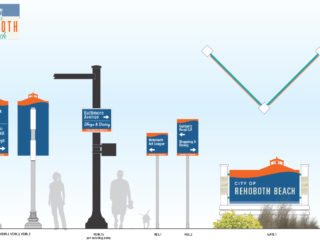
City hears wayfinding overhaul options
Hot Springs – Sign systems direct motorists and pedestrians to key destinations more seamlessly when they are designed according to an overarching theme, a consultant told city and tourism officials earlier this week.
Glen Swantak of MERJE Environments and Experiences of Pennsylvania said inconsistency of appearance and message disjoints the wayfinding experience, making signs seem like discrete elements rather than components of a unified whole.
“Wayfinding isn’t new to Hot Springs,” Swantak told officials. “We have wayfinding. It’s just not organized. It’s an unorganized system with different sizes and different colors. The goal is to organize that information. The thing we noticed is inconsistency of messaging on the banners out there now. We’re saying maybe there’s a better way to organize that information.”
Swantak’s firm was hired to implement the $398,000 Federal Lands Access Program grant the U.S. Department of Transportation awarded the city to improve its wayfinding system. The three design themes he presented coalesce around features unique to the city, he said. A more refined version of one concept or a composite of all three will be presented later this year, with input solicited from officials and the public earlier this week helping to inform the final product.
A committee of city planning and engineering staff will decide the ultimate concept.
The option Swantak characterized as “active” draws on the area’s appeal to outdoor enthusiasts.
“It’s sleeker, modern, contemporary,” he said of the design. “Water is an element that can be used for this design. You’ve got water in the springs, water in the lakes. It’s everywhere.”
The “historic design” option mimics the look of downtown light poles, with signs displaying changeable banners announcing upcoming events.
“You can see how this really starts to feel like this matches what’s out there currently,” he said. “It fits right into the existing streetscape. It has the historical architectural features.”
The “nature” option aligns with the design of National Park Service signs. Swantak said brown backgrounds could indicate National Park points of interest and green backgrounds could be used for city destinations.
“It brings more natural elements into the signing system,” he said.
Swantak said signs at the approaches of the city need to be large, leading the way to general areas such as downtown. Deeper into the city, they can direct traffic to more specific locations, such as downtown attractions. Pedestrian signs are the least conspicuous but need to convey the most information. Swantak said he foresees extensive use of them downtown.
Whatever the approach, Swantak said it needs to be specific to Hot Springs.
“We don’t have a formula or system,” he said. “We really try hard to find what is unique to Hot Springs and use that as a design element we can apply to the signs. There’s a lot to pull from. I don’t know if it’s necessarily one thing.”
David Showers | The Sentinal Record



